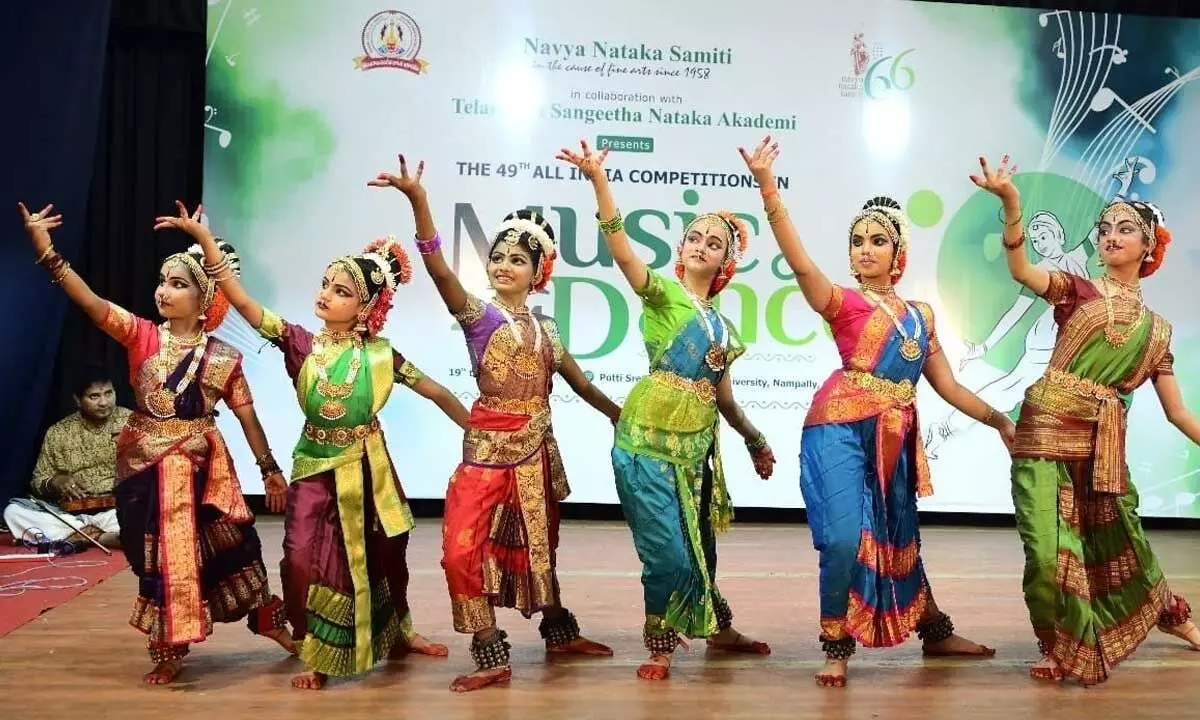Navya Nataka Samiti: Instilling a Sense of Discipline, Art, and Devotion

The Navya Nataka Samiti Competition, a prestigious event in the realm of classical arts, has nurtured discipline, artistry, and devotion for nearly 50 years.
The Navya Nataka Samiti Competition, a prestigious event in the realm of classical arts, has nurtured discipline, artistry, and devotion for nearly 50 years. With participants showcasing diverse Indian art forms, the competition instills perfection in each performer, while preserving cultural heritage and fostering national integration.
A Legacy of Artistry
For nearly half a century, the Navya Nataka Samiti has conducted a prestigious competition that serves as a beacon of discipline, artistry, and dedication. Next year marks the 50th Telangana competition, a testament to the organizers’ enduring passion for the classical arts.
A Diverse Showcase of Cultural Traditions
The competition features participants from across India's rich cultural landscape, including Kuchipudi, Kathak, Bharata Natyam, Carnatic Vocal, Hindustani music, Carnatic violin, and mridangam. Unique to this competition is its strict adherence to a syllabus prescribed by the Telangana Nataka Samiti. Each performance is judged live, with senior dancers allotted 30 minutes, juniors 15 minutes, and sub-juniors 10 minutes. Specific dance pieces, such as Padamu, Javali, and Ashtapadi, are prepared, but judges may only request one, testing both preparation and spontaneity.
The Bhama Kalapam Challenge
A standout feature is the requirement for a 30-minute Bhama Kalapam performance, where dancers must embody Satya Bhama throughout without breaking character—a true test of devotion to the art form. The competition has seen legends like Junior NTR, Priya Sisters, and Radha-Raja Reddy begin their journey here, showcasing the rich talent that emerges from this rigorous event.
A Visionary Leader's Insight
Vemaraju Vijay Kumar, President of NNS, shared, "I grew up watching my father, IAS cadre, Commissioner, who was passionate about the arts and started this. After 40 years with the Department of Atomic Energy, I recognize the vital support from donors and sponsors for the Navya Nataka Samiti. Our commitment to excellence has allowed us to thrive for nearly half a century. We connect with the youth in a family-like atmosphere, and this year, we've welcomed around 385 competitors, showcasing a remarkable increase in participation."
Cultural Preservation and National Integration
“The competition is more than a contest—it is a movement of cultural preservation,” emphasised Vijay Kumar, noting its role in promoting national integration through traditional North and South Indian art forms. Over the years, organizers have formed a close-knit family, with participants hailing from diverse regions like Bihar, Madhya Pradesh, and Bangalore.
Commitment to Excellence
Strict judging criteria reflect the Academy's commitment to preserving the purity and perfection of classical Indian dance. Ananda UVL, Chairperson of NNS, a former journalist and classical dancer, serves as one of the judges. She emphasised the importance of high standards: “A flawless performance is essential. The discipline instilled here sets the foundation for future artists.”
The Role of Detail in Performance
Madhumathi Kulkarni, a key convenor, highlighted the significance of detail in judging: “Candidates are evaluated on every aspect, from lost ornaments to dressing style and expressions. Everything must be flawless to keep the audience engaged. Our competition's uniqueness lies in its syllabus, item length, live music, and the large number of competitors.”
A Legacy of Support and Inspiration
Punja Vijay Kumar’s commitment to dance extends beyond his family. He has been honoured for his extraordinary work with specially-abled children, particularly training a deaf and mute child named Lakshmi. Kumar’s son, Bhuvaneshwar, exemplifies this legacy, having won second prize in the 2017 edition of the competition. With his outstanding performances, Bhuvaneshwar is confident in his chances of success this year. “Never leave our roots; dance is life,” he advises his children.
The Transformative Power of the Arts
The Navya Natya Samiti stands as a testament to the passion for the art form shared by all organizers. Each child performs with intense focus and passion, often accompanied by nervousness. While we see apprehension before they step onto the stage, that fear dissipates as they become entranced by the music, leading the audience on a captivating journey.
In an era dominated by AI, our cultural roots remain unshakeable. Traditional classical dances are the essence of our heritage. Regardless of globalisation's impact, every Indian finds solace in reconnecting with these roots, accessible through traditional dance courses that showcase our vast cultures.The children’s costumes, jewellery, expressions, and lip-syncing are meticulously judged, with prizes awarded to honour their hard work and talent.
Navya Nataka Samiti introduces participants to new styles of the dances they have cherished throughout their lives, guiding them on a journey of discipline, perfection, and devotion to their beloved art forms. The stage is set to cultivate beautiful-minded citizens of India, empowering children to embark on a path of self-discipline, self-discovery, and ultimately, successful, self-loving lives.







